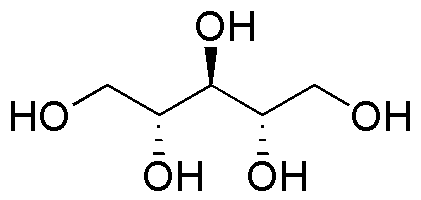Adonitol is widely utilized in research focused on:
- Pharmaceutical Development: It serves as a key ingredient in the formulation of certain medications, particularly in the development of sugar alcohols that can be used as sweeteners or bulking agents in drug formulations.
- Microbiology: Adonitol is used as a carbon source in culture media for the growth of specific bacteria, aiding researchers in studying microbial metabolism and behavior.
- Food Industry: As a sugar substitute, it finds application in low-calorie food products, helping manufacturers cater to health-conscious consumers seeking alternatives to traditional sugars.
- Biochemical Research: It is utilized in various biochemical assays and experiments, particularly in studies involving carbohydrate metabolism, providing insights into metabolic pathways.
- Cosmetic Formulations: Adonitol is incorporated into skincare products for its moisturizing properties, enhancing the texture and efficacy of creams and lotions.
General Information
Properties
Safety and Regulations
Applications
Adonitol is widely utilized in research focused on:
- Pharmaceutical Development: It serves as a key ingredient in the formulation of certain medications, particularly in the development of sugar alcohols that can be used as sweeteners or bulking agents in drug formulations.
- Microbiology: Adonitol is used as a carbon source in culture media for the growth of specific bacteria, aiding researchers in studying microbial metabolism and behavior.
- Food Industry: As a sugar substitute, it finds application in low-calorie food products, helping manufacturers cater to health-conscious consumers seeking alternatives to traditional sugars.
- Biochemical Research: It is utilized in various biochemical assays and experiments, particularly in studies involving carbohydrate metabolism, providing insights into metabolic pathways.
- Cosmetic Formulations: Adonitol is incorporated into skincare products for its moisturizing properties, enhancing the texture and efficacy of creams and lotions.
Documents
Safety Data Sheets (SDS)
The SDS provides comprehensive safety information on handling, storage, and disposal of the product.
Product Specification (PS)
The PS provides a comprehensive breakdown of the product’s properties, including chemical composition, physical state, purity, and storage requirements. It also details acceptable quality ranges and the product's intended applications.
Certificates of Analysis (COA)
Search for Certificates of Analysis (COA) by entering the products Lot Number. Lot and Batch Numbers can be found on a product’s label following the words ‘Lot’ or ‘Batch’.
*Catalog Number
*Lot Number
Certificates Of Origin (COO)
This COO confirms the country where the product was manufactured, and also details the materials and components used in it and whether it is derived from natural, synthetic, or other specific sources. This certificate may be required for customs, trade, and regulatory compliance.
*Catalog Number
*Lot Number
Safety Data Sheets (SDS)
The SDS provides comprehensive safety information on handling, storage, and disposal of the product.
DownloadProduct Specification (PS)
The PS provides a comprehensive breakdown of the product’s properties, including chemical composition, physical state, purity, and storage requirements. It also details acceptable quality ranges and the product's intended applications.
DownloadCertificates of Analysis (COA)
Search for Certificates of Analysis (COA) by entering the products Lot Number. Lot and Batch Numbers can be found on a product’s label following the words ‘Lot’ or ‘Batch’.
*Catalog Number
*Lot Number
Certificates Of Origin (COO)
This COO confirms the country where the product was manufactured, and also details the materials and components used in it and whether it is derived from natural, synthetic, or other specific sources. This certificate may be required for customs, trade, and regulatory compliance.


